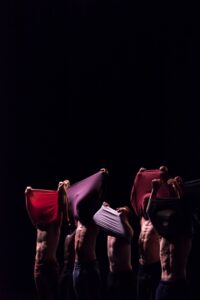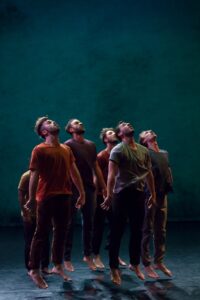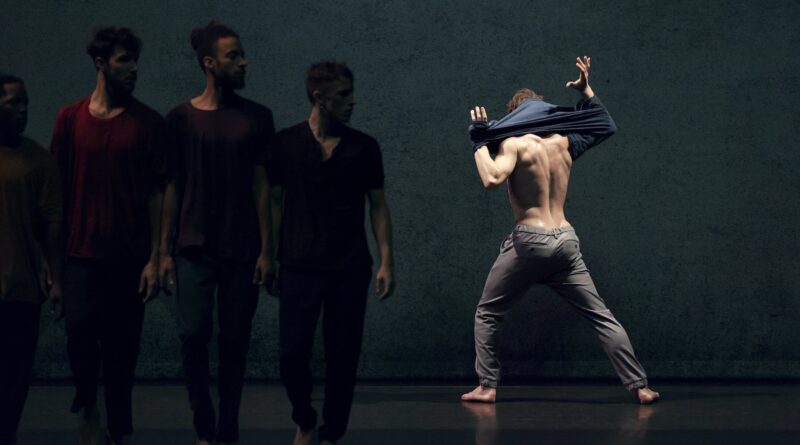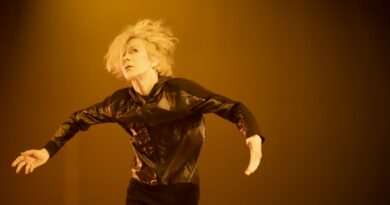Choreographer Fouad Boussouf’s Näss mesmerizes and confounds

Näss, which opened the 5th season of Harbourfront Centre’s Torque International Contemporary Dance Series on October 26 – 28, is a mesmerizing dance performance that begins in darkness with a slow, hypnotic act of unveiling. It draws the audience from crepuscular half-light into a mysterious journey of reverberating rhythm and movement. The show, choreographed by Moroccan-born, France-based artist Fouad Boussouf, is an utterly unique exploration of movement and culture.
The performance begins with the distant howling of the wind, and as the lights rise, seven shadows emerge – faintly, barely — from a cloudy backdrop. At first, it seems like these figures are approaching the audience, but as the light slowly increases, it becomes apparent that we the viewers are moving towards them. This intriguing beginning sets the tone for the performance: expect the unexpected.
Moving in slow, slow motion, the seven men on stage don what we soon can see are their jackets . . . and as the music shifts from street sounds to a pulsating beat, they break into a synchronized dance, moving with the rhythm. At times, one dancer separates from the group, gazing upwards with outstretched hands.
“Näss,” meaning “people” in Arabic, draws its inspiration from the iconic 1970s Maghreb Moroccan ensemble known as Nass el Ghiwane, celebrated across Africa for their fusion of traditional Moroccan music with lyrics deeply rooted in political and social injustices. This performance seamlessly blends the fluid movements of urban hip-hop, street, and breakdance styles with contemporary and traditional North African dance.
The dance language in Näss combines contemporary hip-hop and breaking with traditional Moroccan influences of Gnawa and Reggada. While watching, audiences are transported to the vibrant streets of Morocco, where the contemporary and the traditional meet. The individual, paired and collective dancing of the seven male performers maps the intricate dynamics of individuality within a community, exploring its complexities, conflicts, and contradictions.
The choreography, performed by Sami Blond, Mathieu Bord, Elie Tremblay, Yanice Djae, Ackciel Régent Gonzàlez, Justin Gouin and Maëlo Hernandez, is dynamic, featuring bursts of breathtaking athleticism interwoven with hypnotic footwork. Each dancer has a powerful solo moment that showcases impressive feats such as handstands, floor spins, and flips. The choreography also includes duets, and the moments where the dancers play with negative space created by each other’s absence, are especially inspired.
 According to a program note, Boussouf created the work “like a breath, simultaneously physical and mystical”, and rooted it “in the ground and in one’s land in order to feel its vibrations”. This mysterious-sounding pronouncement is both apt and insightful. The tension between the dancers’ gravity and their spiritually charged vibrations is palpable throughout the performance — especially as the energy of the performers ebbs and flows.
According to a program note, Boussouf created the work “like a breath, simultaneously physical and mystical”, and rooted it “in the ground and in one’s land in order to feel its vibrations”. This mysterious-sounding pronouncement is both apt and insightful. The tension between the dancers’ gravity and their spiritually charged vibrations is palpable throughout the performance — especially as the energy of the performers ebbs and flows.
As the lights eventually begin to dim, the dancers take turns leaping into the air – seemingly with abandon. Their steady stepping seems to lift them off the ground, and as the returning twilight deepens, they resume their starting positions, facing the hazy backdrop.
Boussouf’s piece explores the eternal quest for something ineffable – something beyond, that may be spiritual or physical. The universal language of dance, suggests Näss, is a path through the darkness. Walk it together, and we can find those sought-after good vibrations.
© Arpita Ghosal, Sesayarts Magazine, 2023
About The Author
Arpita Ghosal
Arpita Ghosal is a Toronto-based arts writer. She founded Sesaya in 2004 and SesayArts Magazine in 2012.
Visit About Us > Meet the Team to read Arpita’s full bio …



